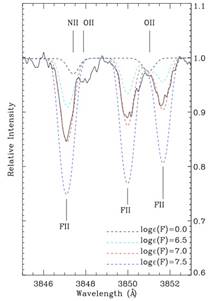Ministry of Science & Technology
Detection of fluorine in hot Extreme Helium Stars solves their evolution mystery
प्रविष्टि तिथि:
21 JUN 2020 5:49PM by PIB Delhi
An extreme helium star or EHe is a low-mass supergiant that is almost devoid of hydrogen, the most common chemical element of the universe. There are 21 of them detected so far in our galaxy. The origin and evolution of these Hydrogen deficient objects have been shrouded in mystery. Their severe chemical peculiarities challenge the theory of well-accepted stellar evolution as the observed chemical composition of these stars do not match with that predicted for low mass evolved stars.
A study by the Indian Institute of Astrophysics (IIA) an autonomous institute of Department of Science and Technology which detected the presence of singly ionised fluorine for the first time in the atmospheres of hot Extreme Helium Stars makes a strong case that the main formation of these objects involves a merger of a carbon-oxygen (CO) and a Helium (He) white dwarf.
The research published in the Astrophysical Journal, led by Anirban Bhowmick (Ph.D. student, IIA, Bengaluru), Prof. Gajendra Pandey (IIA) and Prof. David Lambert (University of Texas at Texas-Austin), which showed fluorine abundances determined from singly ionized fluorine (F II) lines suggest a very high enrichment of fluorine, about a factor of 100 to 10000 times higher than normal stars.
Clues to evolution of extreme helium stars require accurate determinations of their chemical composition, and the peculiarities, if any, become very important. Fluorine plays a very crucial role in this regard to determine the actual evolutionary sequence of these hydrogen deficient objects. Severe fluorine enrichment w.r.t normal stars (of the order of 800 − 8000) was observed in the cool EHes along-with the cooler classical hydrogen deficient stars, the RCB variables (R Coronae Borealis Stars) hinting at close evolutionary connection between them. The scientists explored the relationship of hot EHes (EHes having effective temperature ≥ 14000K), with the cooler EHes, based on their fluorine abundance and spotted it in the former, thus establishing an evolutionary connection across a wide range of effective temperature.
High-resolution echelle spectra of 10 hot EHes were obtained from Hanle Echelle Spectrograph (HESP) mounted on the 2-m Himalayan Chandra Telescope at the Indian Astronomical Observatory (IAO) in Hanle, Ladakh, (remotely operated by IIA) including data from McDonald Observatory, USA, and ESO archives.
By comparing the observed fluorine abundances with other abundances of the key elements, the scientists could determine the formation channels responsible for fluorine enrichment. The varied range of observed fluorine abundance across stars having similar atmospheric parameters points out the difference in the individual star’s evolution and the ensuing nucleosynthesis. Particularly, the enrichment of fluorine in the atmospheres of carbon-rich EHes and absence of the same in carbon-poor EHes suggest that fluorine is profusely produced during the merger of a He-CO WD resulting in a carbon-rich EHe, whereas He-He WD merger that results in carbon-poor EHes does not account for fluorine overabundance.
The detection of enhanced fluorine abundances in the atmospheres of hot EHes solves a decade-old mystery about their formation. It firmly places hot EHes in an evolutionary sequence with cool EHes and other hydrogen-deficient stars and zeros in on the evolutionary scenario, which involves the merger of two double degenerate white dwarfs (WDs).
(Publication details: The Astrophysical Journal, Volume 891, Issue 1, id.40 https://iopscience.iop.org/article/10.3847/1538-4357/ab6e6d)

Figure 1: Observed F ii lines in 3850 ̊A window of the hot EHe V2205 Oph (solid line) with key lines marked. Synthetic spectra are shown for four fluorine abundances.
*****
NB/KGS/(DST)
(रिलीज़ आईडी: 1633191)
आगंतुक पटल : 2309